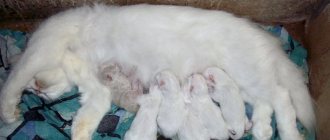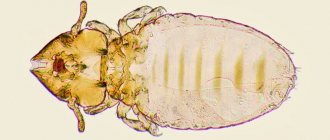The behavior of cats differs from the behavior of other animals, although their nervous system is built in much the same way as that of all mammals. Scientific research has shown surprising results: some parts of the cat's brain are even more developed than those of dogs, which affects the analysis of information and reactions. Thanks to this, cats are able to both learn and ignore learning, depending on how much they consider the skill necessary to learn.
The cat's brain in the evolution of the cat family
In terms of its dimensions, a cat is a miniature creature, the exception, of course, is the Maine Coon breed. However, it is wrong to think that if an animal is smaller than a person, it means it is stupider and less intellectually developed than a person. Scientists have proven that the mass of this biological computer does not affect intelligence at all. In addition, its structure has existed without any significant changes for tens of millions of years. Even the first representatives of the cat family on Earth had exactly the same structure of this organ. They were replaced by the ancestors of lions, tigers, panthers, etc. And then these representatives themselves. It is worth noting that the filling of a lion’s skull in its structure is an exact copy of the filling of the skull of any domestic or street cat. The differences are only due to the habitat and body mass. The greater the body weight, the greater the functions of the trunk that need to be controlled, the more space in the skull for “gray matter”
What does science say?
Another sign of cat intelligence is a refusal to participate in research.
David Grimm writes in the online publication Slate that two leading animal researchers with whom he discussed feline intelligence had great difficulty working with their subjects because the cats simply did not participate in the experiments and did not follow directions. Leading animal scientist Dr. Adam Miklosi even had to go to the cats' home because in his laboratory they categorically did not make contact. However, the more scientists learn about cats, the more they want to try to subdue them. You just need to get them to follow commands, but it is obvious that this is very difficult.
Cat brain structure
As already noted, the cat’s brain is a kind of biological computer, the main function of which is to process information from various senses and control the animal’s movements.
Conventionally, this biological computer can be divided into several elementary parts:
- cerebral cortex,
- body - gray matter under the cortex;
- cerebellum.
Most of the cerebral cortex is responsible for processing auditory information. This property helps the cat when hunting, both in the wild and at home. The rest of the cortex processes the remaining information coming from the other sensory organs, which, for example, include the eyes of a cat, the organs of smell, etc.
The body of the brain, a substance located under the cortex that people usually call gray matter, although it can be pink and in some individuals green, is responsible for many of the operations performed by the pet. This includes heart contraction, eye blinking, and even yawning.
The cerebellum is the part of the brain responsible for movement and coordination. It is thanks to her that the pet can easily maintain balance on the eaves of the house, on the balcony and on the tree. It also affects speed and swiftness.
Thus, the cat’s brain is the most complex mechanism that controls the body quickly and smoothly, allowing the animal to show itself not only from the side of a pet, but also from the side of a dangerous predator.
Nervous system
The central nervous system is represented by the brain, spinal cord and brain stem. It receives and transmits signals and commands to the peripheral nervous system.
The brain is the main organ of the central nervous system of cats. The normal size of a cat's brain is 5 centimeters in length. Domesticated breeds have a smaller brain volume than wild breeds. Otherwise, the physiology of domestic cats changes slightly compared to wild cats.
© shutterstock
The peripheral nervous system includes the entire system of nerves in the animal's body - nerves in the skull and spinal cord, plexuses of nerve fibers and nerve endings . This system is responsible for motor activity, reflexes, and pain.
The autonomic nervous system ensures the autonomous functioning of all internal organs. It is also responsible for the cat’s innate reflexes associated with hunting, food production, protection, reproduction, and orientation in terrain and space.
The cat's brain as the basis of intelligence
These amazing creatures have a number of innate instincts, such as marking and defending territory, hunting, breeding and much more. However, living next to a person, their life is regularly influenced by him. Thus, while raising kittens, a person influences the brain activity of the ward, thereby forming the basic inclinations of the pet’s behavior. And this precisely suggests that the brain component is the main source of intelligence. It is worth noting that street animals differ significantly in character and behavior from domestic ones. If the latter have unlimited trust in their owner, then street animals can only rely on themselves, and, as a rule, behave more intelligently, inventively and dexterously. And it is right. After all, life on the street is full of dangers that await the inhabitants of the street literally at every step. Here you need to behave carefully and even with caution.
Many people believe that a cat cannot be taught anything. This misconception is based on the fact that the cat’s brain , unlike the same organ of a human or dog, is not adapted to a herd lifestyle. These creatures are simply not instinctively accustomed to society. However, domestic cats, which from the very first months are in the company of their owner, can be trained and master certain skills and habits necessary for living next to a person. The owner can teach his pet such commands as “No”, “Come to me”, “Eat”, etc. At worst, does the cat learn to go to the litter box ? This fact itself indicates the presence of intelligence in the animal.
Who is smarter - cats or dogs?
So, the age-old question still remains open: which animal is smarter, a cat or a dog?
The answer depends on who you ask. Dogs were domesticated much earlier than cats, they are more trainable and are more social creatures, but this does not mean that cats are less intelligent than dogs. It's impossible to know for sure because cats are inherently difficult to study.
Dr. Miklosi, who typically studies dogs, has discovered that, like dogs, cats have the ability to understand what other animals, including humans, are trying to communicate to them. Dr. Miklósi also determined that cats do not ask their owners for help the way dogs do, mainly because they are not as “tuned” to people as dogs are. “They're on a different wavelength,” says Grimm, “and that ultimately makes them very difficult to study. Cats, as any owner knows, are very intelligent creatures. But to science, their minds may forever remain a black box.” Isn't it the mysterious nature of cats that makes them so irresistible?
It may take some time before scientists can answer more concretely the question of how smart cats are. What is known is that cats are impatient, have highly developed cognitive decision-making skills, and will leave you if they find you boring. Moreover, they are great at knocking your arrogance down.
But if a cat loves you, she will always love you. By properly understanding how smart your cat is, you can establish a strong bond between you for many years to come.
Do you want to test the intelligence of your mustachioed and striped friend? Take the intellectual quiz for cats on the Petcha website!
Follows the finger
Early training can help cats
tune in to human signals such as finger pointing.
One study found that cats can find food when a person points it out.
More recent research shows that cats can even distinguish between human voices.
People view cats as independent, aloof, and selfish.
But when they see how social these animals can be, the debate stops. It is very important to understand their behavior and how they see and understand the world around them.
Organs of the circulatory system
The process of blood circulation, like the internal structure of a cat, is practically no different from a similar process in other mammals. It is provided by two circles of blood circulation. The first is the transport of blood from the heart to the capillaries through the arteries. The second is the transportation of venous blood to the heart and lungs.
The pulse in cats should be measured on the inside of the thigh, where the femoral artery is located. A healthy adult at rest has a heart rate of up to 130 beats per minute.
Similar to humans, cats' blood can have different groups: A, B, AB. Group AB, as in humans, is the rarest. Most often cats have group A.
Cats' blood clots much faster than humans'..
Structure of the National Assembly and provoking factors
The basis is created by neuron cells. When neurons come into contact, reflex circuits are formed through which nerve impulses pass.
- CNS (brain, spinal cord).
- Peripheral (cranial and spinal nerves connecting the central trunk with receptors of tissues and organs).
Factors that can provoke a nervous system disorder include anything that changes the animal’s usual life.
- change of owner or place of residence;
- riding public (personal) transport;
- visit to the veterinary clinic;
- abrupt transition from one food to another;
- weaning from the mother cat;
- holidays (guests, fireworks, music).
A special place is given to the physical ailments of the cat, in which it experiences pain and discomfort. This also includes veterinary manipulations associated with “improving” appearance, or with preventive methods (castration, sterilization, declawing, etc.).
Emotional stress causes the development of deep neuroses. Although this is not a prerequisite, cats, just like people, have individual characteristics. Some react inadequately to moving the tray, while others are not bothered by loud music in the room, washing, or long trips in the car.
The breeder’s task is to know how sensitive their pet is and to prevent unnecessary worries!
Cat's internal clock
Another study tried to understand whether cats have an internal clock.
According to scientists, cats have them because they lead an active lifestyle at dusk and dawn. It is important for them to know when to hunt and when to rest.
It is noteworthy that when cats live next to us
, they are smart enough to change their natural behavior. The man got out of bed, which means this is a signal. It's getting lighter outside, which means it's time to eat. Cats make different connections and this is called associative learning.
Organs of the digestive system
The digestive tract of cats is provided with such organs:
- Mouth . Consists of lips, cheeks, tongue, gums, palate (soft and hard), teeth, tonsils, pharynx and salivary glands.
- Throat . Serves to connect the nasal cavity with the lungs, the oral cavity with the esophagus. Covered with mucous membrane and has strong muscles.
- Esophagus . Serves to transport food from the mouth through the pharynx to the stomach. Consists of skeletal muscles, the contraction of which helps move food.
- Stomach . Has one camera. Located in the abdominal cavity (front). Food enters the stomach, is stored in it and processed into chyme, which then enters the small intestine.
- Intestines . The total length of a cat's intestines is about 2 meters. The intestines are 3 times longer than the cat’s entire body.
- Small intestine . It is about 1.5 meters long. The main process of digestion of proteins and carbohydrates occurs in the small intestine.
- Colon . In the colon, the final breakdown and absorption of useful substances occurs, as well as the removal of residues in the form of feces.
- Pancreas . The ducts of the small intestine exit into it. Over the course of one day, it secretes several liters of a special secretion, which helps break down substances supplied with food.
- Gallbladder and liver . Filters blood that comes from the stomach and intestines. The liver produces bile, which is necessary for processing fats.
Respiratory system
The anatomy of a cat is not much different from other mammals. This also applies to the respiratory system. It includes the following organs :
- bronchi;
- larynx;
- lungs.
- nose;
- nasopharynx;
- trachea;
© shutterstock The breathing process begins from the nose and nasopharynx.
The nose has 2 nasal cavities inside, in which, when inhaled, the process of recognizing odors, heating the air and purifying it from impurities, dust, and debris occurs. The cavities are separated by a septum of hyaline cartilage. The larynx is located between the trachea and pharynx, and is located above the hyoid bone. Main functions of the larynx :
- air conduction;
- preventing food from entering the respiratory system;
- formation of sounds.
The larynx consists of five movable cartilages and a mucous membrane. It also contains the vocal cords, vocal muscle and glottis. This is where all the sounds that a cat makes are produced.
The purring of cats occurs due to the special location and functioning of the organs of the larynx. Purring occurs without effort on the part of the animal, and has the same rhythm as breathing. In this case, the muscles contract at a frequency of more than 1000 times per minute.
The vocal cords of cats differ in their structure from the vocal cords of other animals. Attentive owners may notice that the pet’s “speech” is not limited to meowing. And even ordinary meowing can be different. It is quite simple to study the “language” of your cat, and you can accurately guess what exactly the pet is telling us. For example, dogs can only make about 10 different sounds. And representatives of some cat breeds can express themselves using about 100 sounds that exist in their “lexicon”.
A healthy animal in a calm state takes about 20-25 breaths per minute. Kittens take breaths and come out more often.
External factors that provoke the appearance of nervous disorders
Any changes that cause bright, negative emotions in a cat can cause disruptions in the functioning of the nervous system and the formation of various diseases. In most cases, abnormalities in the functions of the central nervous system in a pet appear when:
- moving to another place of residence;
- traveling in public transport, car;
- visiting veterinary hospitals;
- participation in exhibition events;
- change of owner;
- changing the interior, etc.
Of course, it is not always possible to completely avoid such situations. It should be noted that these factors do not cause neurological diseases for all animals. Owners need to be attentive to their pets, thoroughly study their characteristics and emotional reactions to various stimuli. This will reduce the risk of disorders and keep the cat healthy.
Often, disorders of the nervous system are the result of infectious, viral diseases. Therefore, it is necessary to pay special attention to prevention, timely vaccination, and minimize the risk of contact with sick animals.
If any serious ailments occur, it is necessary to contact professionals for diagnosis and treatment. You cannot independently determine the type of disease, choose procedures, medications. Many medications have side effects and contraindications. A qualified doctor will select the necessary funds and determine the optimal dosage, taking into account the condition, age of the pet, and the stage of development of the disease. The recommendations of a specialist should be strictly followed. An untreated disease can become chronic and cause complications in the form of neuralgic pathologies, which are extremely difficult to get rid of.
Understanding Human Reaction
Scientists in Christine Vitale's lab are studying how cats understand and respond to social cues, specifically a person's emotional response to an unfamiliar situation.
In one test, scientists told the cat owner to either be afraid
, or enjoy a fan that might seem scary to a cat.
Next, the researchers looked at whether the cat picked up on human emotional signals. If the owner is afraid
, does the cat look at the object with caution?
And if the owner is happy
, does the cat try to interact with the object?
Smart cats understand the emotional state of their owners.
Ability to Attach
In one study, owners and their cats walked in together
to the laboratory. Then the scientists “took” the owner out of the room, leaving the cat alone.
In 2 minutes
the owner returned to reunite with the cat. Here's what scientists noticed:
- Some cats met their owner
, and then went back to explore the room. These cats were strongly attached to their owner.
- Another group of cats
after the owner returned, she was dissatisfied with his departure, and therefore began to scratch him.
- But there was a third group
, which did not react in any way to the return of a familiar person - these cats simply sat and ignored everything that was happening. This is due to the fact that they have long established a connection with the owner.











